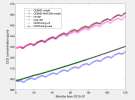What version of the code are you using?
- CESM2.1.3
Have you made any changes to files in the source tree?
- No, except necessary changes of xml files like cores, STOP_OPTION, etc.
Describe your problem or question:
- I run a default case of compset BSSP370cmip6 based on historical restart file ‘b.e21.BHIST.f09_g17.CMIP6-historical.010_v2’ from 2015 to 2024, which use CAM6 as atmospheric component and BDRD for ocean biogeochemistry. As I know the BDRD means ocean biogeochemistry will use diagnostic CO2 as atmospheric forcing. As the attachment shows, the predicted CO2 change in CESM2-WACCM is closer to the ocean module forcing in the SSP370 scenario, while CESM2-CAM6 predicts a higher CO2 forcing (~ 30 ppm) than the WACCM and ocean module CO2 forcing.
In the figure, CESM2-cmip6 is downloaded from CMIP6, ScenaroMIP with r4i1p1f1; CESM2-WACCM-cmip6 is also downloaded from CMIP6-ScenarioMIP with r1i1p1f1. The ctl-def and owe-def are control run of compset BSSP370cmip6. CO2forcing-ctl and CO2forcing-owe are atmospheric CO2 forcing to ocean module.
So, I wonder what are the main differences between WACCM and CAM? Is WACCM more suitable for BDRD Settings than CAM If I want to analyze the effect of the ocean on atmospheric carbon dioxide? And what is the effect of run number (r1, r4 ...) on my simulation?

- CESM2.1.3
Have you made any changes to files in the source tree?
- No, except necessary changes of xml files like cores, STOP_OPTION, etc.
Describe your problem or question:
- I run a default case of compset BSSP370cmip6 based on historical restart file ‘b.e21.BHIST.f09_g17.CMIP6-historical.010_v2’ from 2015 to 2024, which use CAM6 as atmospheric component and BDRD for ocean biogeochemistry. As I know the BDRD means ocean biogeochemistry will use diagnostic CO2 as atmospheric forcing. As the attachment shows, the predicted CO2 change in CESM2-WACCM is closer to the ocean module forcing in the SSP370 scenario, while CESM2-CAM6 predicts a higher CO2 forcing (~ 30 ppm) than the WACCM and ocean module CO2 forcing.
In the figure, CESM2-cmip6 is downloaded from CMIP6, ScenaroMIP with r4i1p1f1; CESM2-WACCM-cmip6 is also downloaded from CMIP6-ScenarioMIP with r1i1p1f1. The ctl-def and owe-def are control run of compset BSSP370cmip6. CO2forcing-ctl and CO2forcing-owe are atmospheric CO2 forcing to ocean module.
So, I wonder what are the main differences between WACCM and CAM? Is WACCM more suitable for BDRD Settings than CAM If I want to analyze the effect of the ocean on atmospheric carbon dioxide? And what is the effect of run number (r1, r4 ...) on my simulation?

